Over 60 attend "Safety & Survival at Sea Training for Commercial Fisherman on June 4 in Montauk
Although popularized by phrases like “the most dangerous catch” or “the deadliest catch,” it is not an exaggeration that commercial fishermen put their lives on the line when they go out to sea to bring your favorite seafood to the table. On Friday, June 4, 2010, 60 Long Islanders, most of them commercial fishermen, participated in a basic safety and survival at sea training held at Inlet Seafood Packing House in Montauk, NY.
During the free daylong workshop, fishermen learned about survival gear and were instructed on life-saving tips about fire fighting, the use of flares and how to respond to flooding on their vessels. The certified instructors, Ted Williams, Rodney Avila and Tom Toolis were from the IMP Marine Group in New Bedford, Massachusetts with training through the rigors of the Alaska Marine Safety Education Association. The fishermen were divided into groups and got hands-on experience at each of several stations with an opportunity to inspect and don their own immersion suit, deploy and board a life raft, put out the type of fire that can break out in an engine room, release a rocket flare, cast a life ring and plug a simulated leak in a boat using basic materials.
“Without a doubt, I’d rather learn here on the dock than offshore when it’s 5 degrees in February,” said John Scheu who’s been long lining for 27 years and currently goes out for tile fish on the Kimberly docked at Inlet Seafood. The Kimberly’s captain, Dave Tuma, and owner, Dan Farnham, were also in attendance.
The instructors focused on seven steps to survival:
- Recognition: Admit that your life is in danger. Act!
- Inventory: Decide what can help and hurt. Do First Aid.
- Shelter: Preserve body heat with materials that insulate and protect you from the environment.
- Signals: Help rescuers find you.
- Water: Find a safe source of water. Drink two to four quarts a day.
- Food: After you are safe and warm, food will help long waits.
- Play: Stay busy and keep a positive mental attitude.
This ambitious training was organized by Antoinette Clemetson, fisheries specialist from New York Sea Grant in Riverhead and John Scotti of Cornell Marine Program. Emerson Hasbrouck of Cornell Marine Program said, “We have not had such training available in over ten years.” Hasbrouck participated himself, and also in attendance was his son, a marine scientist, and the members of his staff. Said Jackie Stent of the Cornell Cooperative program, “We’re first responders to the marine community and we must have certification for survival at sea provided by this one-day course.”
Lt. David Barnes of the US Coast Guard Marine Safety Detachment and his Unit provided a trailer that was used to teach fishermen how to address flooding incidents onboard. Some key points learned included: have all crew members know the location and operation procedures for the vessel’s pumping system; use any number of methods –power-driven, hand and/or fire pups, buckets – to de-water, keeping bilges dry and preventing loss of stability; and, if on a small vessel, crew should remain evenly distributed.
“There’s always something new to learn,” said 62-year old Bruce Beckwith who started clamming at age 12. “And I learned a lot today.”
Rodney Avila, IMP Certified Marine Safety Instructor heard several fisherman say they had no idea how to properly use the life saving equipment on their boats. One captain, after practicing the four-man life raft and seeing how crowded it was, decided to purchase a bigger life raft. It was also the first time that several fishermen had seen a flare ignited.
At the end of the day, each participated received a certificate of attendance to keep in their wallet. Everyone walked away learning something and fishermen were asking if there was any plan to hold another safety training in the near future.
Bill Grimm and Kevin Maguire, two of the partners at Inlet Seafood, thought the day was a great success. Antoinette Clemetson of New York Sea Grant and the other organizers were greatly appreciative to Inlet for providing such a good location – and weather – for the event.
Such a free training session would not have been possible without the financial support of the New York Center for Agricultural Medicine and Health (NYCAMH) which primarily serves farming communities in central New York. The NYCAMH Director, John J. May, MD, said, “We receive support from New York’s Occupational Health Clinic Network and from the federal government to reduce the impact of occupational hazards in farming, forestry and fishing. Fishermen play an essential role in feeding our society, working remarkably hard under challenging conditions and experiencing high rates of occupational injury. Our goal is to see that these people recognize the risks and are trained in proper safety precautions.”
Another partner was the Long Island Occupational and Environmental Health Center (LIOEHC), designated and funded by the NYS Department of Health as the Long Island center for the prevention and treatment of work-related health problems. Its director, Linda Cocchiarella, MD, attended the session. “We work with NYCAMH and other groups to keep workers such as fishermen safe at work. If they are injured on the job, we can provide the medical care they need and deserve, regardless of whether they have the ability to pay. Fishermen have a very dangerous job and we want them to know there is always help available.”
During a free raffle, LIOEHC generously donated a fifteen flotation bibs. A grand prize, an immersion suit, was donated by IMP and won by fisherman Dave Aripotch of the Caitlin & Mairead. Breakfast and lunch were provided by Ocean Marine Insurance Agency, Inc.
New York Sea Grant, a cooperative program of the State University of New York, Cornell University and the National Oceanic and Atmospheric Administration (NOAA), sponsors research, extension and education programs to promote the wise use of New York’s marine and Great Lakes resources.
Information on LIOEHC can be obtained at www.lioehc.net.
– Barbara A Branca, New York Sea Grant Communications Manager
In Photos: Safety and Survival At Sea Training
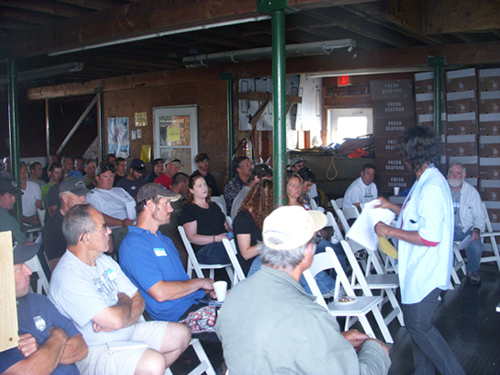
Over 60 Long Islanders, most of them commercial fishermen, attended the "safety & survival at sea" training. Photo by Rodney M. Avila.
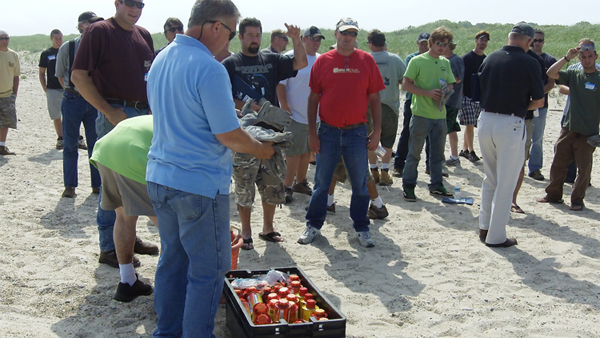
On the Montauk beaches, fishermen learned were instructed on the use of flares, including the proper way to hold and ignite them. Photo by Paul C. Focazio, NYSG.
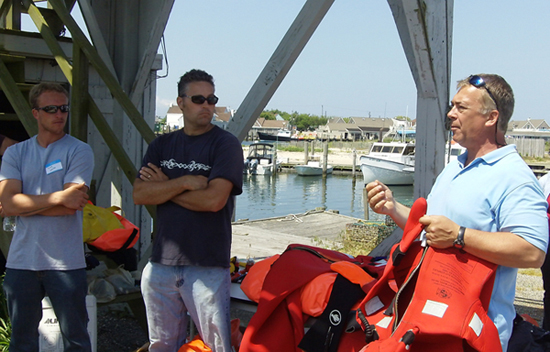
Another key "safety at sea" tip: survival gear, including Immersion suits, PFDs and inflatable life rafts. Photo by Paul C. Focazio, NYSG.
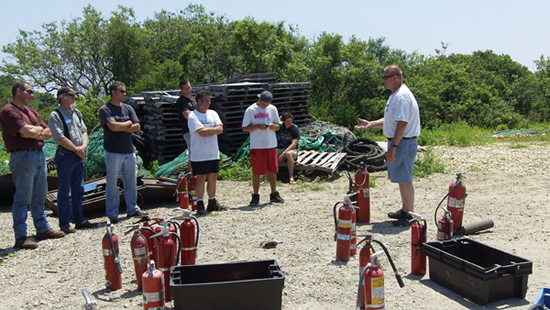
Fishermen learned life-saving tips about fire fighting. In a situation where there's an uncontrollable fire, they were instructed to notify Coast Guard and nearby vessels. Photo by Paul C. Focazio, NYSG.
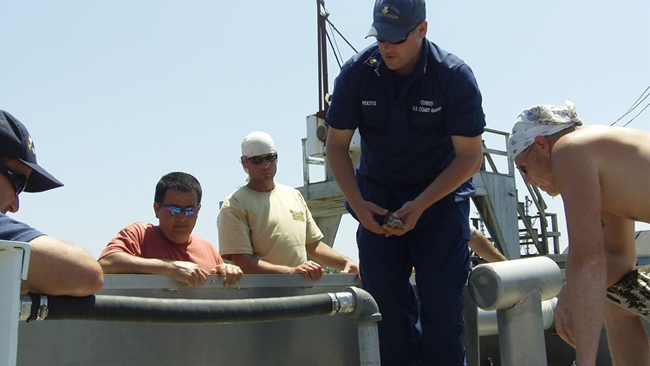
The U.S. Coast Guard provided a trailer used to teach fishermen how to address flooding incidents onboard. Photo by Paul C. Focazio, NYSG.
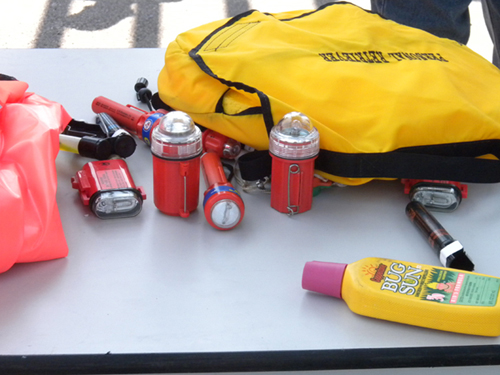
Some of the safety materials (for you and the vessel) that should be onboard include: flashlights and sunscreen (pictured), as well as flares, a handheld radio and a first aid kit. Photo by Barbara A. Branca, NYSG.
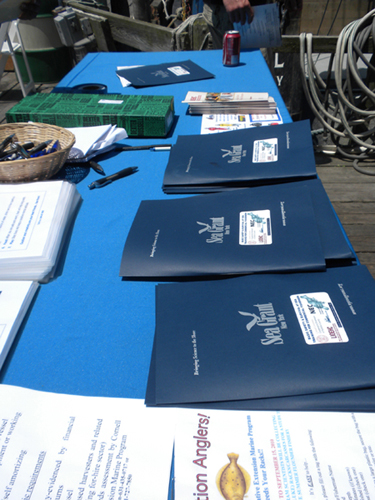
Packets handed out to attendees included safety and cold water survival tips as well as an orientation summary. Photo by Barbara A. Branca, NYSG.
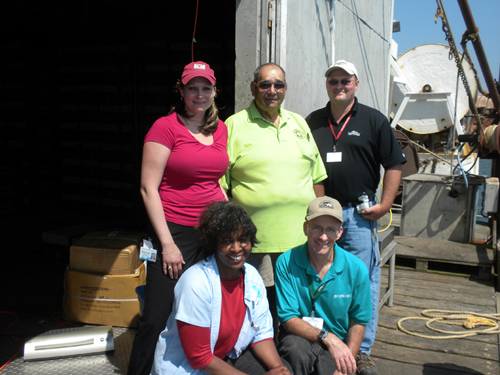
NYSG and Cornell Cooperative Extension partners with several others to make this event possible, including the New York Center for Agricultural Medicine and Health, and the Long Island Occupational and Environmental Health Center. Photo by Barbara A. Branca, NYSG.